Experimental Characterization of an Embossed Capacitive Micromachined Ultrasonic Transducer Cell
Abstract
1. Introduction
2. Design and Fabrication of Embossed CMUT
2.1. Embossed CMUT Design
2.2. Embossed CMUT Fabrication
3. Characterization of Embossed CMUT
3.1. Optical Metrology Characterization
3.2. Electrical Characterization
3.3. Acoustic Characterization
4. Discussion
5. Conclusions
Author Contributions
Funding
Acknowledgments
Conflicts of Interest
References
- Oralkan, O.; Ergun, A.S.; Johnson, J.A.; Karaman, M.; Demirci, U.; Kaviani, K.; Lee, T.H.; Khuri-Yakub, B.T. Capacitive micromachined ultrasonic transducers: Next-generation arrays for acoustic imaging? IEEE Trans. Ultrason. Ferroelectr. Freq. Control 2002, 49, 1596–1610. [Google Scholar] [CrossRef]
- Caronti, A.; Caliano, G.; Carotenuto, R.; Savoia, A.; Pappalardo, M.; Cianci, E.; Foglietti, V. Capacitive micromachined ultrasonic transducer (CMUT) arrays for medical imaging. Microelectron. J. 2006, 37, 770–777. [Google Scholar] [CrossRef]
- Butterfly Network Inc. Ultrasound, Ultra-Simplified. Available online: https://www.butterflynetwork.com/ (accessed on 29 January 2020).
- Tawfik, H.H.; Alsaiary, T.; Elsayed, M.Y.; Nabki, F.; El-Gamal, M.N. Reduced-gap CMUT implementation in PolyMUMPs for air-coupled and underwater applications. Sens. Actuators A Phys. 2019, 294, 102–115. [Google Scholar] [CrossRef]
- Park, S.; Yoon, I.; Lee, S.; Kim, H.; Seo, J.-W.; Chung, Y.; Unger, A.; Kupnik, M.; Lee, H.L. CMUT-based resonant gas sensor array for VOC detection with low operating voltage. Sens. Actuators B Chem. 2018, 273, 1556–1563. [Google Scholar] [CrossRef]
- Pun, S.H.; Yu, Y.; Zhang, J.; Wang, J.; Cheng, C.-H.; Lei, K.F.; Yuan, Z.; Mak, P.U. Monolithic Multiband CMUTs for Photoacoustic Computed Tomography With In Vivo Biological Tissue Imaging. IEEE Trans. Ultrason. Ferroelectr. Freq. Control 2018, 65, 465–475. [Google Scholar] [CrossRef] [PubMed]
- Brenner, K.; Ergun, A.S.; Firouzi, K.; Rasmussen, M.F.; Stedman, Q.; Khuri–Yakub, B.P. Advances in Capacitive Micromachined Ultrasonic Transducers. Micromachines 2019, 10, 152. [Google Scholar] [CrossRef]
- Huang, Y.; Zhuang, X.; Haeggstrom, E.O.; Ergun, A.S.; Cheng, C.-H.; Khuri-Yakub, B.T. Capacitive micromachined ultrasonic transducers with piston-shaped membranes: fabrication and experimental characterization. IEEE Trans. Ultrason. Ferroelectr. Freq. Control 2009, 56, 136–145. [Google Scholar] [CrossRef] [PubMed]
- Guldiken, R.O.; Zahorian, J.; Yamaner, F.Y.; Degertekin, F.-L. Dual-electrode CMUT with non-uniform membranes for high electromechanical coupling coefficient and high bandwidth operation. IEEE Trans. Ultrason. Ferroelectr. Freq. Control 2009, 56, 1270–1276. [Google Scholar] [CrossRef]
- Kim, D.K.; Chung, S.-W.; Jeong, B.-G.; Hong, S.-W.; Shin, H. An indirectly clamped capacitive micromachined ultrasonic transducer with a high electromechanical coupling factor. Sens. Actuators A Phys. 2013, 203, 82–91. [Google Scholar] [CrossRef]
- Emadi, T.A.; Buchanan, D.A. A novel 6 × 6 element MEMS capacitive ultrasonic transducer with multiple moving membranes for high performance imaging applications. Sens. Actuators A Phys. 2015, 222, 309–313. [Google Scholar] [CrossRef]
- Lee, B.C.; Nikoozadeh, A.; Park, K.K.; Khuri-Yakub, B.T. High-Efficiency Output Pressure Performance Using Capacitive Micromachined Ultrasonic Transducers with Substrate-Embedded Springs. Sensors 2018, 18, 2520. [Google Scholar] [CrossRef] [PubMed]
- Na, S.; Li, Z.; Wong, L.L.; Chen, A.I.-H.; Macecek, M.; Yeow, J. An optimization and comparative study of air-coupled CMUT cells with circular and annular geometries. IEEE Trans. Ultrason. Ferroelectr. Freq. Control 2017, 64, 1723–1734. [Google Scholar] [CrossRef] [PubMed]
- Na, S.; Chen, A.I.; Wong, L.L.; Li, Z.; Macecek, M.; Yeow, J. Capacitive micromachined ultrasonic transducers based on annular cell geometry for air-coupled applications. Ultrasonics 2016, 71, 152–160. [Google Scholar] [CrossRef] [PubMed]
- Shiwei, Z.; Reynolds, P.; Hossack, J.A. Improving the performance of capacitive micromachined ultrasound transducers using modified membrane and support structures. IEEE Ultrason. Symp. 2005, 4. [Google Scholar]
- Park, K.K.; Oralkan, O.; Khuri-Yakub, B.T. A comparison between conventional and collapse-mode capacitive micromachined ultrasonic transducers in 10-MHz 1-D arrays. IEEE Trans. Ultrason. Ferroelectr. Freq. Control 2013, 60, 1245–1255. [Google Scholar] [CrossRef]
- Huang, Y.; Haegstrom, E.; Bayram, B.; Zhuang, X.; Ergun, A.S.; Cheng, C.; Khuri-Yakub, B.T. Comparison of conventional and collapsed region operation of capacitive micromachined ultrasonic transducers. IEEE Trans. Ultrason. Ferroelectr. Freq. Control 2006, 53, 1918–1933. [Google Scholar] [CrossRef]
- Bayram, B.; Oralkan, O.; Ergun, A.S.; Haeggstrom, E.; Yaralioglu, G.G.; Khuri-Yakub, B.T. Capacitive micromachined ultrasonic transducer design for high power transmission. IEEE Trans. Ultrason. Ferroelectr. Freq. Control 2005, 52, 326–339. [Google Scholar] [CrossRef]
- Olcum, S.; Yamaner, F.Y.; Bozkurt, A.; Atalar, A. Deep-collapse operation of capacitive micromachined ultrasonic transducers. IEEE Trans. Ultrason. Ferroelectr. Freq. Control 2011, 58, 2475–2483. [Google Scholar] [CrossRef]
- Yu, Y.; Pun, S.H.; Mak, P.U.; Cheng, C.-H.; Wang, J.; Mak, P.-I.; Vai, M.I. Design of a Collapse-Mode CMUT with an Embossed Membrane for Improving Output Pressure. IEEE Trans. Ultrason. Ferroelectr. Freq. Control 2016, 63, 854–863. [Google Scholar] [CrossRef]
- Yu, Y.; Wang, J.; Pun, S.H.; Cheng, C.-H.; Lei, K.F.; Vai, M.I.; Zhang, S.; Mak, P.U. Fabrication of embossed capacitive micromachined ultrasonic transducers using sacrificial release process. IEICE Electron. Express 2019, 16. [Google Scholar] [CrossRef]
- Zhuang, X. Capacitive Micromachined Ultrasonic Transducers with Through-Wafer Interconnects. Ph.D. Thesis, Stanford University, Stanford, CA, USA, 2008. [Google Scholar]
- Coupland, J.N.; McClements, D.J. Physical properties of liquid edible oils. J. Am. Oil Chem. Soc. 1997, 74, 1559–1564. [Google Scholar] [CrossRef]
- Li, Z.; Zhao, L.; Ye, Z.; Wang, H.; Zhao, Y.; Jiang, Z. Resonant frequency analysis on an electrostatically actuated microplate under uniform hydrostatic pressure. J. Phys. D Appl. Phys. 2013, 46, 195108. [Google Scholar] [CrossRef]
- Li, Z.; Zhao, L.; Jiang, Z.; Ye, Z.; Zhao, Y. An improved method for the mechanical behavior analysis of electrostatically actuated microplates under uniform hydrostatic pressure. J. Microelectromech. Syst. 2015, 24, 474–485. [Google Scholar] [CrossRef]
- Yaralioglu, G.G.; Ergun, S.A.; Khuri-Yakub, B.T. Finite-element analysis of capacitive micromachined ultrasonic transducers. IEEE Trans. Ultrason. Ferroelectr. Freq. Control 2005, 52, 2185–2198. [Google Scholar] [CrossRef] [PubMed]
- Crisfield, M.A. Non-Linear Finite Element Analysis of Solids and Structures; Wiley: Chichester, UK, 1991; Volume 2, pp. 439–440. [Google Scholar]
- Hadian, S.; Gabe, D. Residual stresses in electrodeposits of nickel and nickel–iron alloys. Surf. Coat. Technol. 1999, 122, 118–135. [Google Scholar] [CrossRef]
- George, A.; Di, B. Modern Electroplating; John Wiley and Sons: Hoboken, NJ, USA, 2011; pp. 79–114. [Google Scholar]
- Luo, J.K.; Pritschow, M.; Flewitt, A.J.; Spearing, S.M.; Fleck, N.A.; Milne, W.I. Effects of process conditions on properties of electroplated Ni thin films for microsystem applications. J. Electrochem. Soc. 2006, 153, D155–D161. [Google Scholar] [CrossRef]
- Cetin, A.M.; Bayram, B. Diamond-based capacitive micromachined ultrasonic transducers in immersion. IEEE Trans. Ultrason. Ferroelectr. Freq. Control 2013, 60, 414–420. [Google Scholar] [CrossRef]
- Chanamai, R.; McClements, D.J. Ultrasonic attenuation of edible oils. J. Am. Oil Chem. Soc. 1998, 75, 1447–1448. [Google Scholar] [CrossRef]
- Olcum, S.; Senlik, M.N.; Atalar, A. Optimization of the gain-bandwidth product of capacitive micromachined ultrasonic transducers. IEEE Trans. Ultrason. Ferroelectr. Freq. Control 2005, 52, 2211–2219. [Google Scholar] [CrossRef]

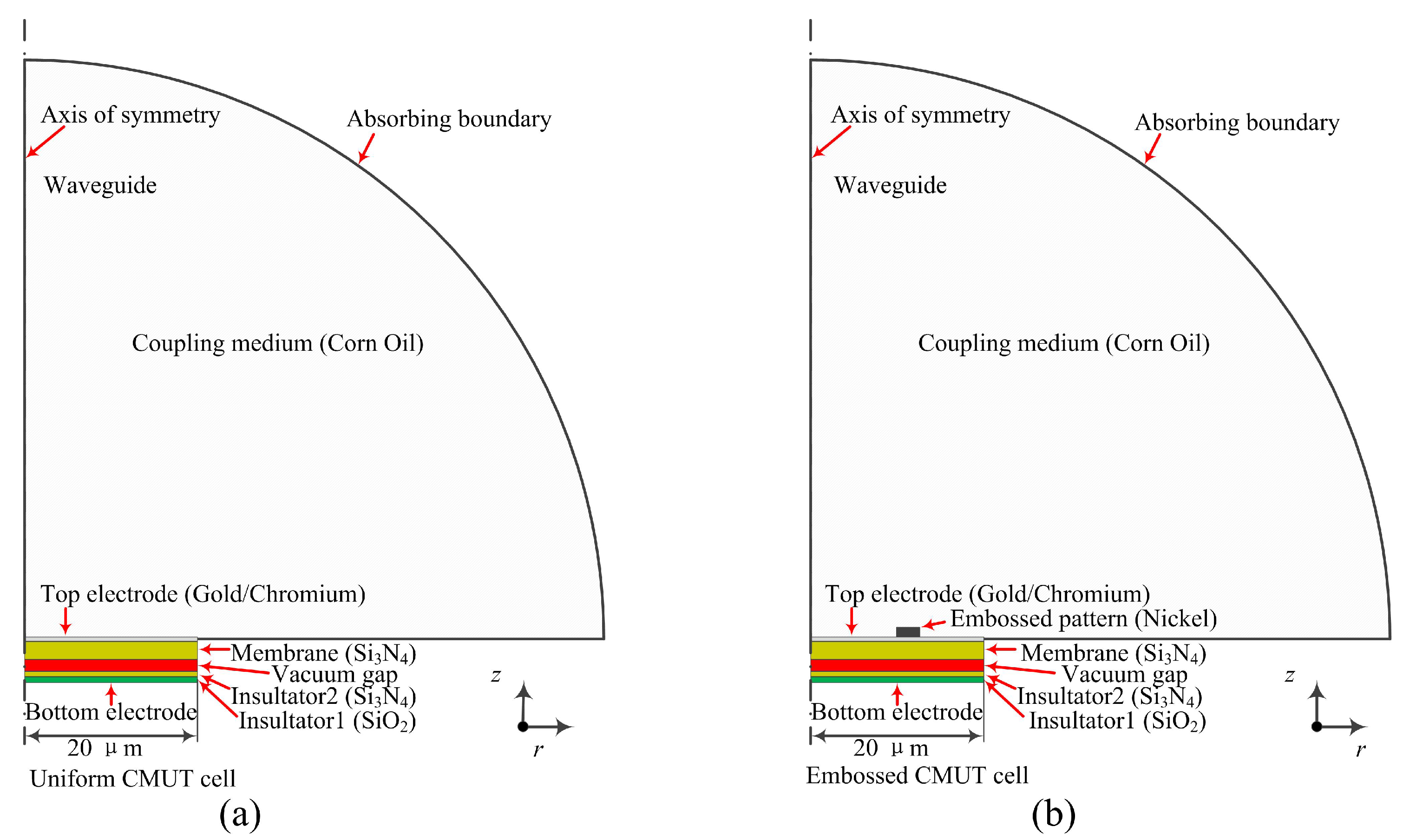
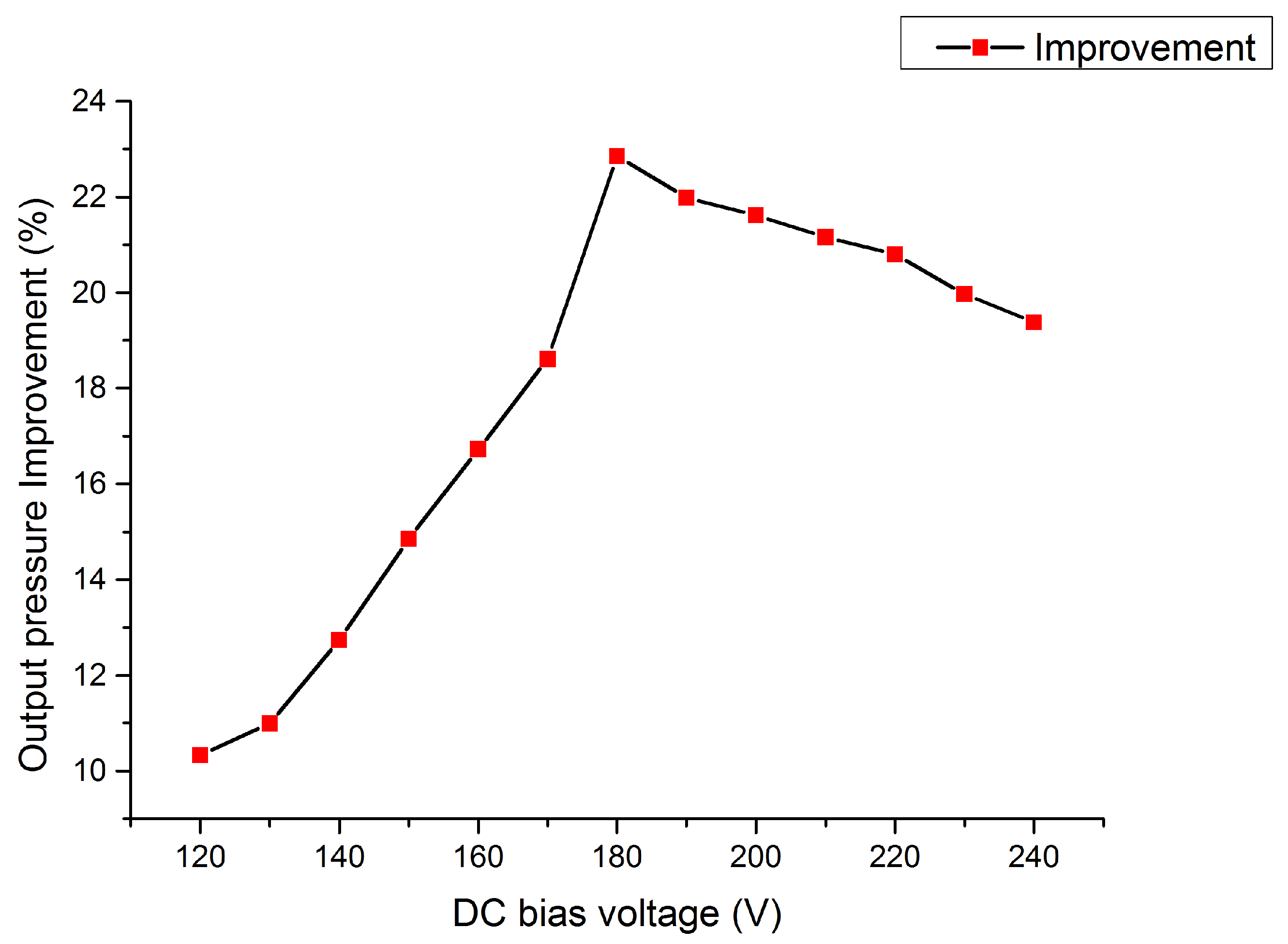
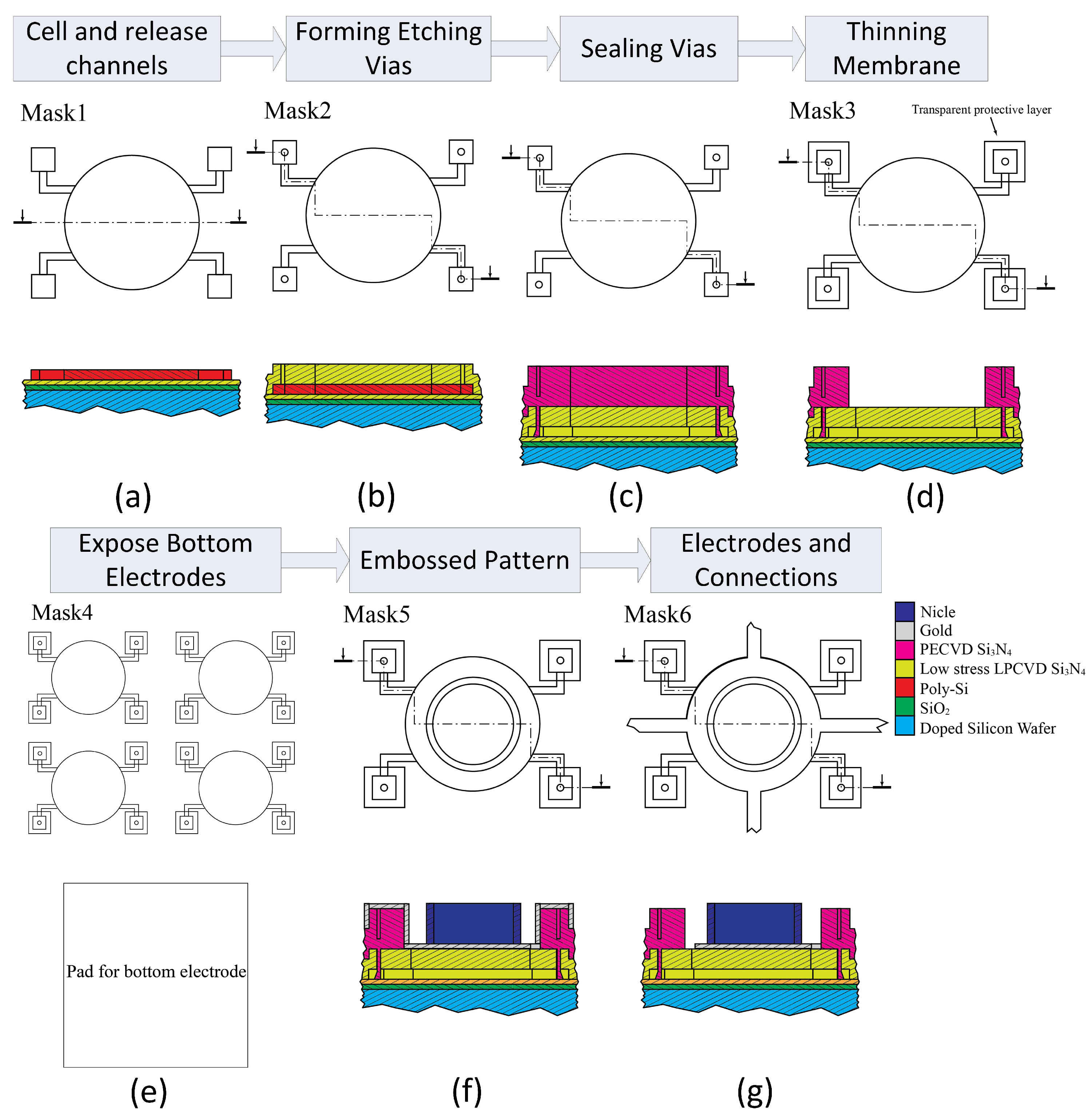
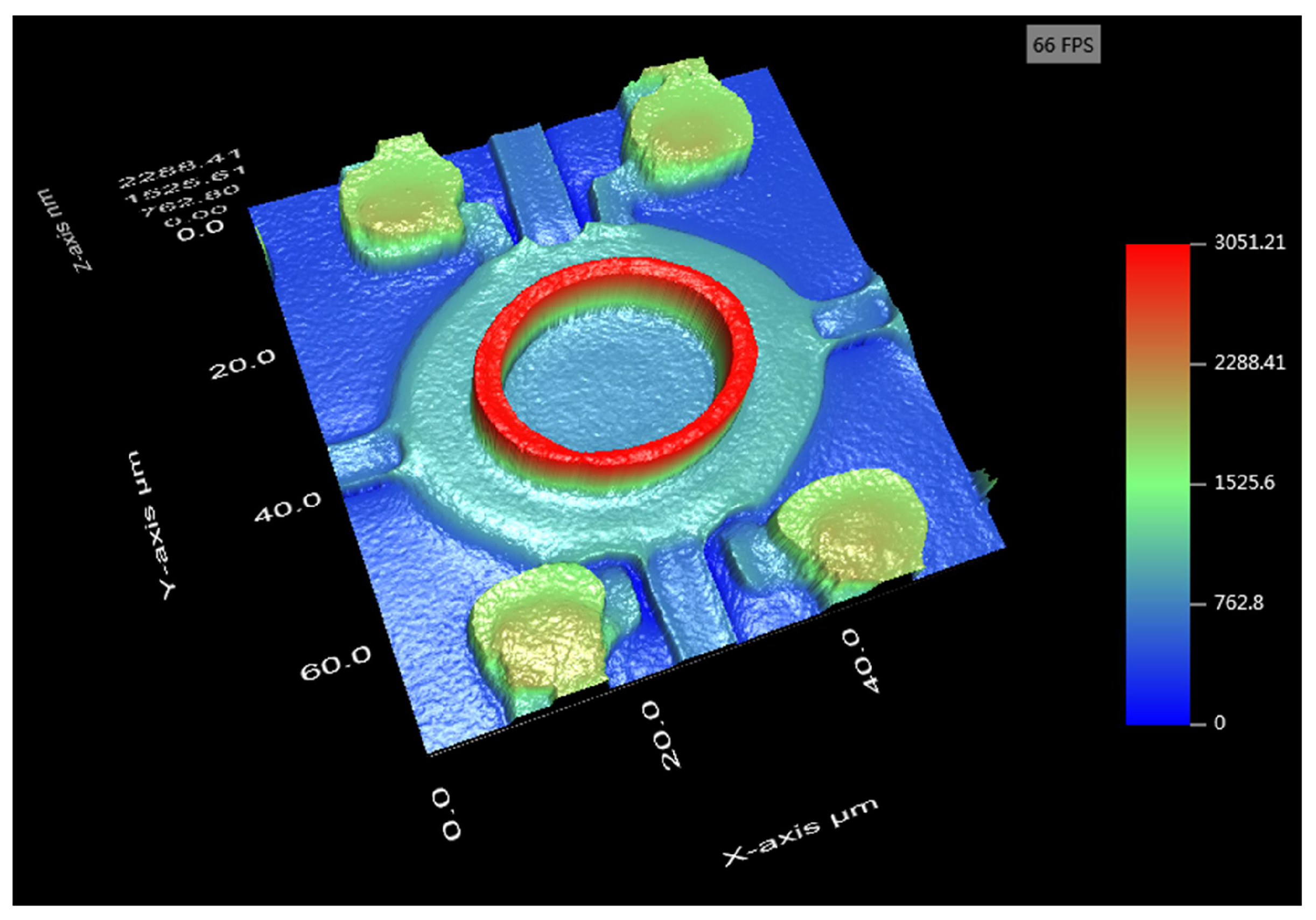
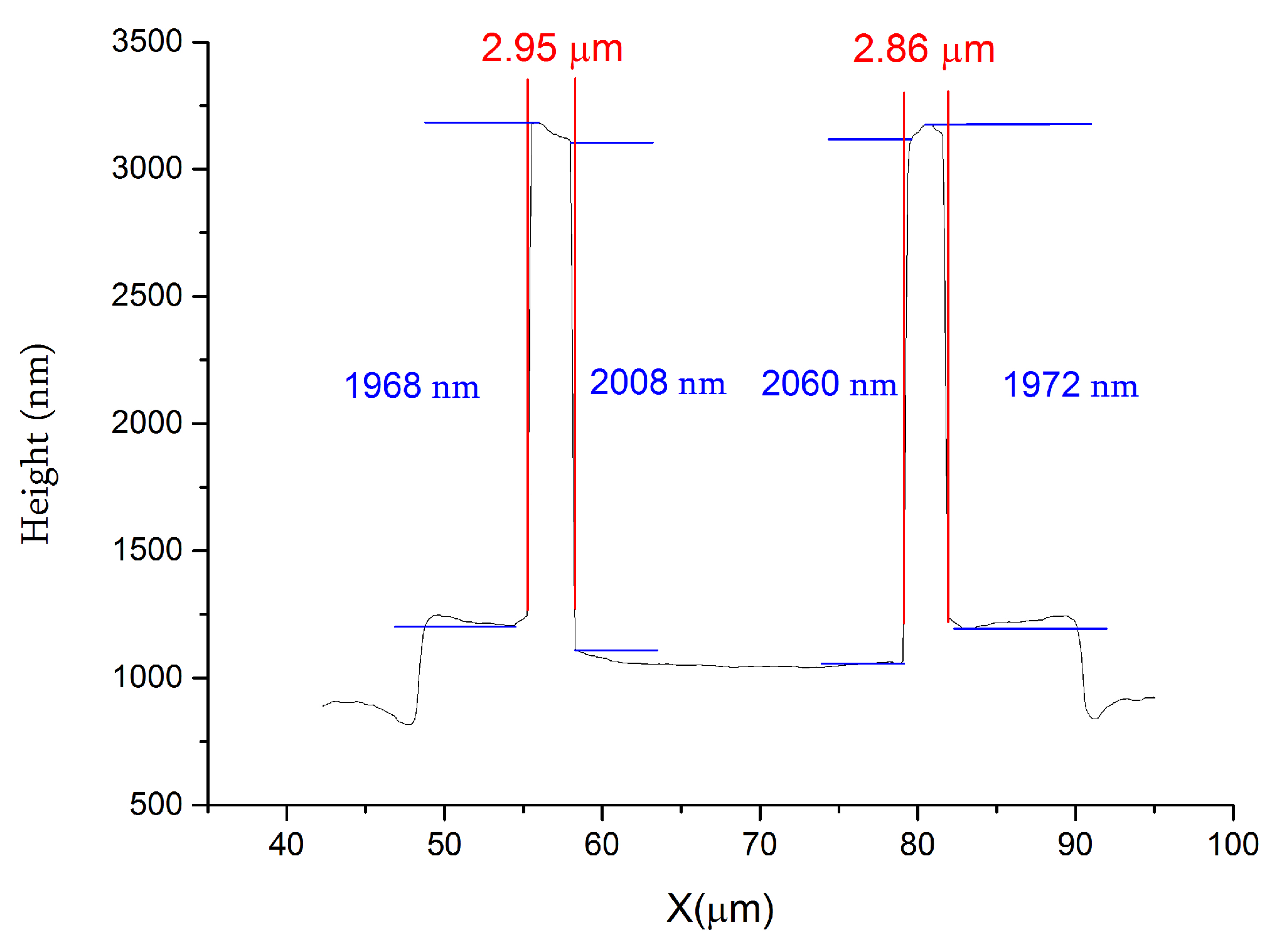
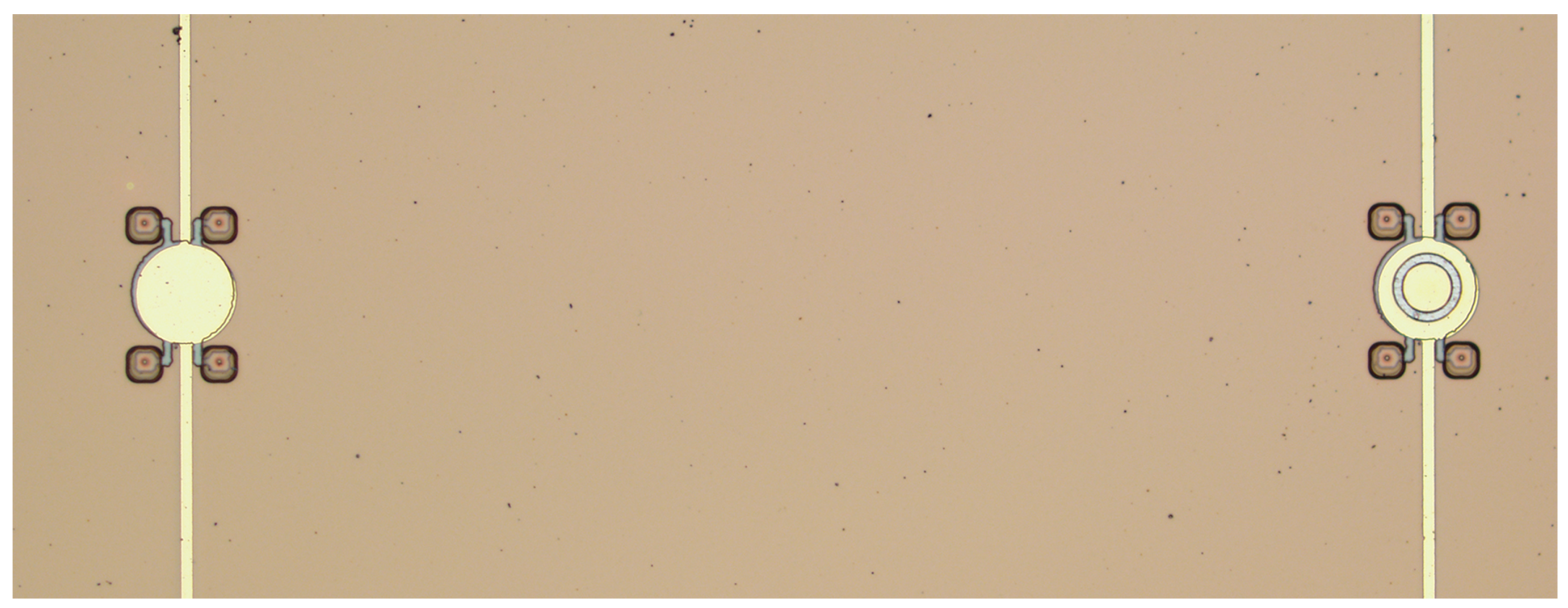
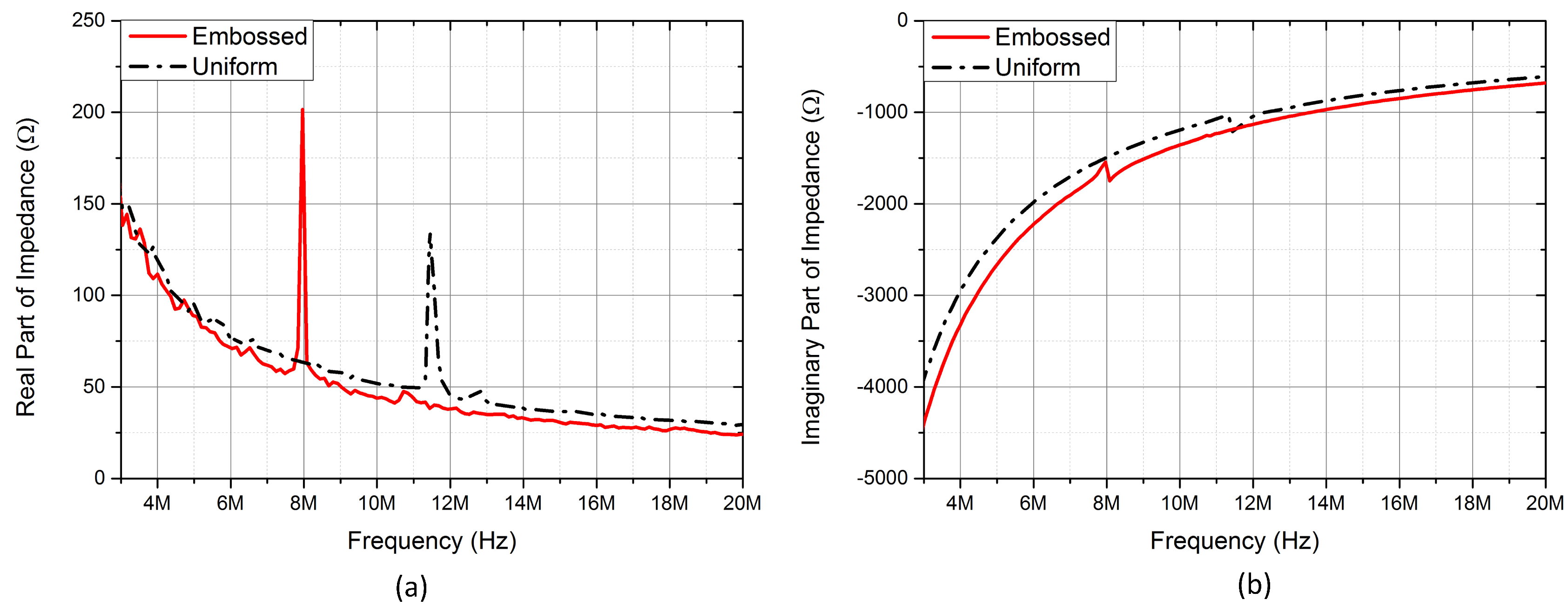
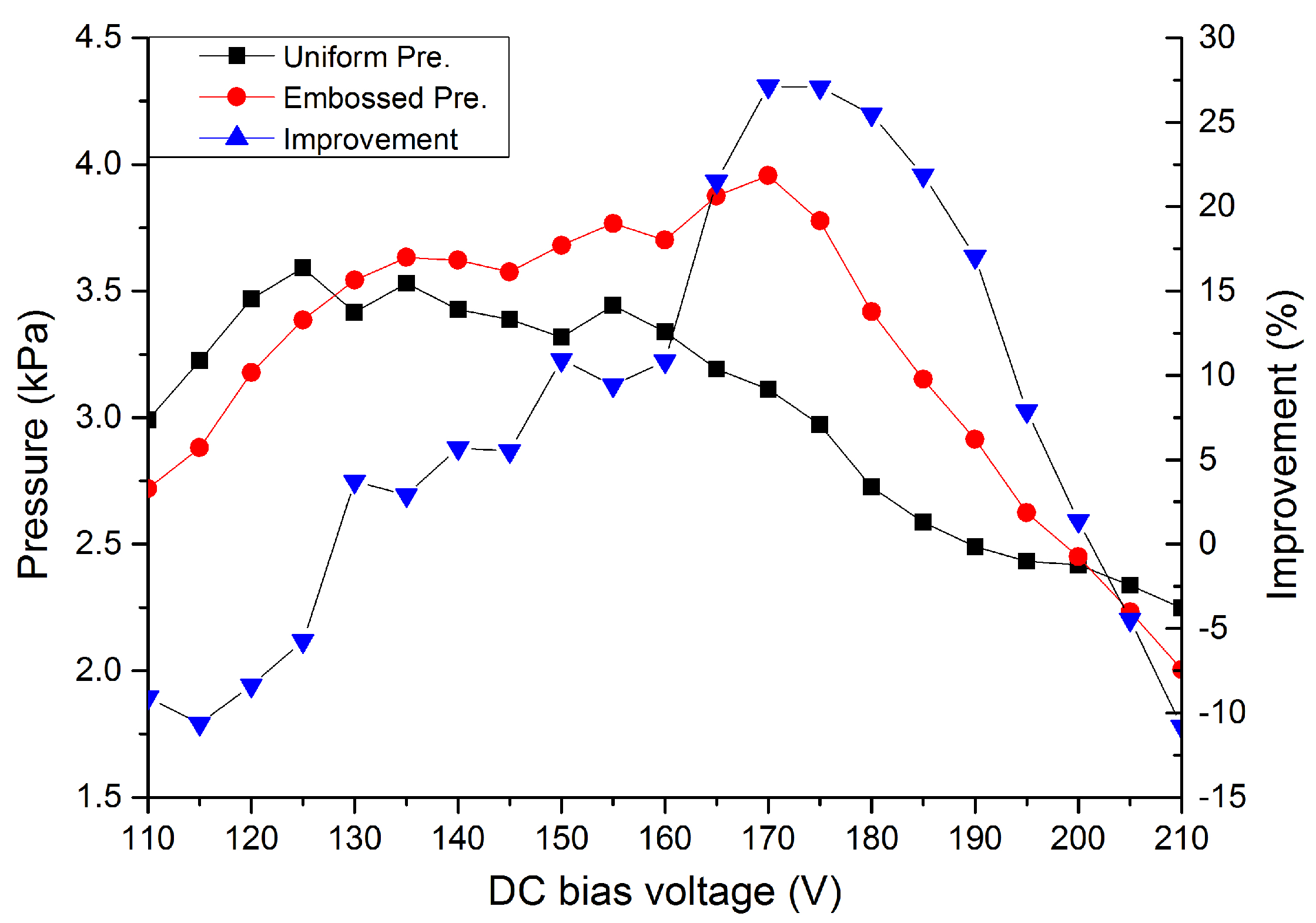
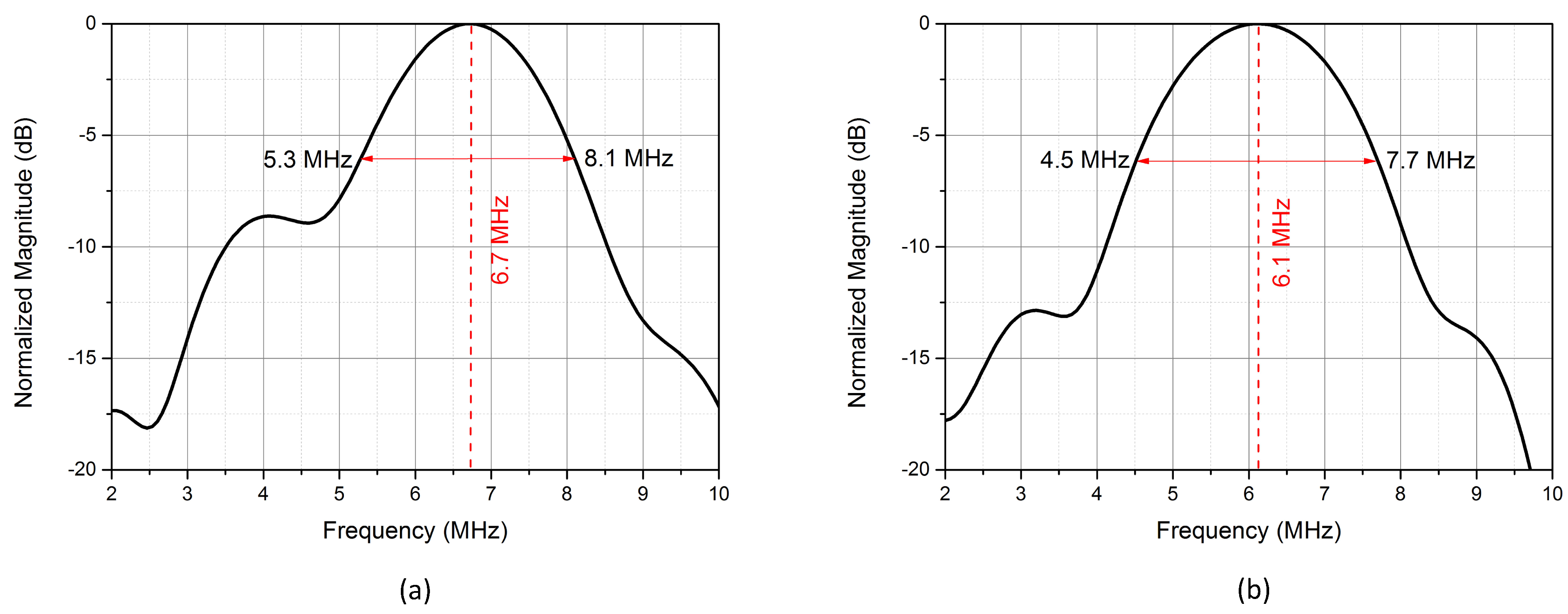
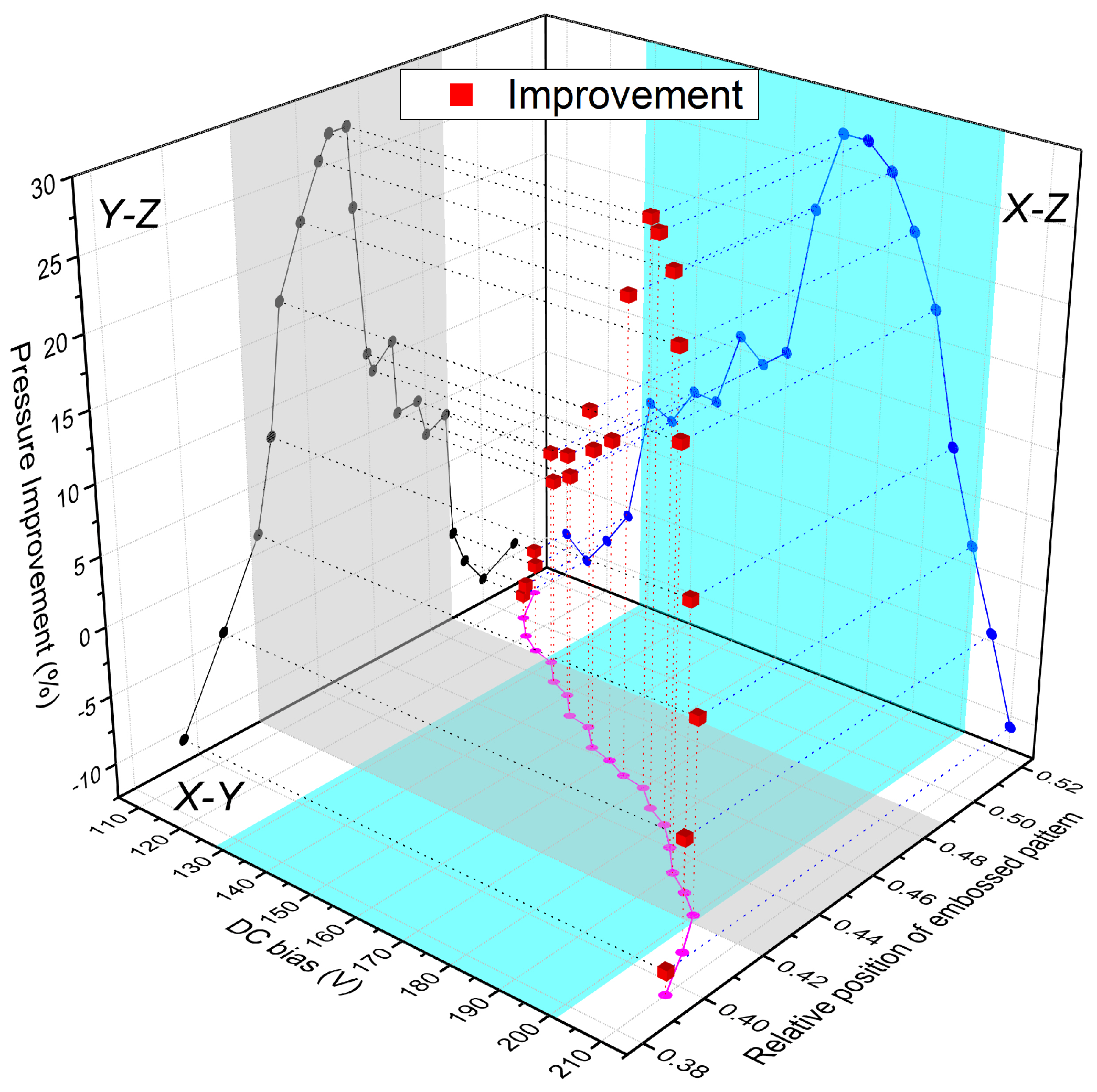
| Dimensions | (m) |
|---|---|
| Membrane (Si3N4) radius | 20 |
| Membrane (Si3N4) thickness | 0.65 |
| Gap height | 0.30 |
| Insulator1 (SiO2) thickness | 0.15 |
| Insulator2 (Si3N4) thickness | 0.15 |
| Top electrode (Gold & Chromium) radius | 20 |
| Top electrode (Gold) thickness | 0.18 |
| Top electrode (Chromium) thickness | 0.02 |
| Embossed pattern (Nickel) width | 3.0 |
| Embossed pattern (Nickel) height | 2.0 |
| Embossed pattern (Nickel) inner radius | 10.5 |
| Embossed pattern (Nickel) outer radius | 13.5 |
© 2020 by the authors. Licensee MDPI, Basel, Switzerland. This article is an open access article distributed under the terms and conditions of the Creative Commons Attribution (CC BY) license (http://creativecommons.org/licenses/by/4.0/).
Share and Cite
Yu, Y.; Wang, J.; Liu, X.; Pun, S.H.; Zhang, S.; Cheng, C.-H.; Lei, K.F.; Vai, M.I.; Mak, P.U. Experimental Characterization of an Embossed Capacitive Micromachined Ultrasonic Transducer Cell. Micromachines 2020, 11, 217. https://doi.org/10.3390/mi11020217
Yu Y, Wang J, Liu X, Pun SH, Zhang S, Cheng C-H, Lei KF, Vai MI, Mak PU. Experimental Characterization of an Embossed Capacitive Micromachined Ultrasonic Transducer Cell. Micromachines. 2020; 11(2):217. https://doi.org/10.3390/mi11020217
Chicago/Turabian StyleYu, Yuanyu, Jiujiang Wang, Xin Liu, Sio Hang Pun, Shuang Zhang, Ching-Hsiang Cheng, Kin Fong Lei, Mang I Vai, and Peng Un Mak. 2020. "Experimental Characterization of an Embossed Capacitive Micromachined Ultrasonic Transducer Cell" Micromachines 11, no. 2: 217. https://doi.org/10.3390/mi11020217
APA StyleYu, Y., Wang, J., Liu, X., Pun, S. H., Zhang, S., Cheng, C.-H., Lei, K. F., Vai, M. I., & Mak, P. U. (2020). Experimental Characterization of an Embossed Capacitive Micromachined Ultrasonic Transducer Cell. Micromachines, 11(2), 217. https://doi.org/10.3390/mi11020217






